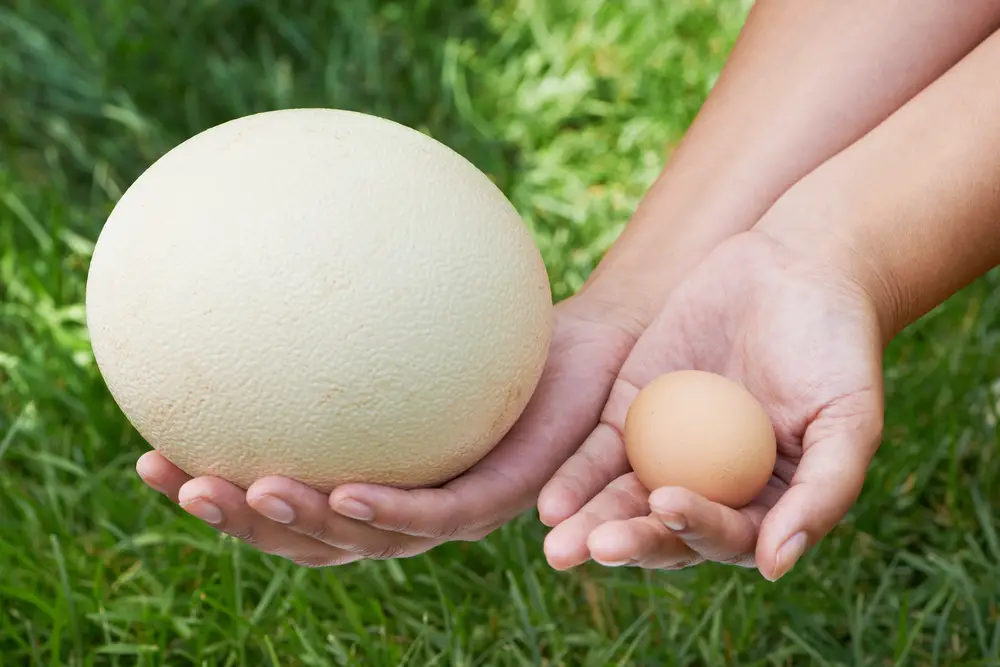Ostrich eggs have been gaining popularity as an alternative to traditional chicken eggs, and many wonder if these giant eggs pack more protein than their smaller counterparts. In fact, the protein content in ostrich eggs does surpass that of chicken eggs, making them an interesting option for those seeking a higher protein source in their diet.
When considering the nutritional aspects of ostrich eggs, it is essential to note that one egg contains roughly the same amount of protein as two dozen chicken eggs. Additionally, these eggs are also high in iron, vitamin B12, and vitamin D, which further supports their value in a healthy and high-protein diet. Their lower fat and cholesterol levels compared to chicken eggs make them an even more appealing choice for health-conscious consumers.
In summary, ostrich eggs do contain more protein than chicken eggs and offer additional nutritional benefits while being lower in fat and cholesterol. For those looking to diversify their protein sources or simply try something new, ostrich eggs present an intriguing option worth exploring.
Ostrich Eggs Vs Other Eggs
Size Comparison
Ostrich eggs are considerably larger than other common types of eggs, such as chicken or duck eggs. In fact, an ostrich egg is equivalent to about 24 large chicken eggs in terms of volume. This significant size difference allows for a larger quantity of nutrients to be packed into a single ostrich egg, making it an incredibly nutrient-dense option compared to its counterparts.
Nutritional Comparison
When it comes to nutritional content, ostrich eggs stand out among other eggs. A single ostrich egg contains approximately 235 grams of protein, making it an excellent source of this essential nutrient. Chicken eggs, on the other hand, typically contain around 6.5g of protein per large egg. Duck eggs are also a good source of protein, with slightly more than a chicken egg, but still far less than an ostrich egg.
Ostrich eggs also offer a number of other valuable nutrients. For example, they contain less cholesterol than chicken eggs, making them a healthier option for people who are monitoring their cholesterol levels. Additionally, ostrich eggs provide more iron and other essential minerals, which are crucial for overall health and wellbeing.
While both hen and duck eggs are nutritious options, the sheer volume and unique nutrient profile of ostrich eggs sets them apart from their smaller counterparts. Incorporating ostrich eggs into a balanced diet can be an effective way to increase protein intake and improve overall nutritional health.
Protein Content of Ostrich Eggs
Ostrich eggs are notably large, with an average weight of up to 3 pounds. Due to their size, these eggs have a significantly higher protein content compared to chicken eggs. On average, one ostrich egg contains 16 grams of protein, which is 2 to 3 times more protein than a large chicken egg.
Interestingly, the protein content in an ostrich egg equates to roughly the same amount as 2 dozen chicken eggs. Additionally, ostrich eggs contain essential amino acids beneficial for overall health and muscle growth.
These eggs are not only high in protein but also rich in other vital nutrients, such as iron, vitamin B12, and vitamin D. Their lower fat and cholesterol content compared to chicken eggs make ostrich eggs a healthier option for those seeking to increase their protein intake without overdoing the calorie or cholesterol count.
Incorporating ostrich eggs into a high protein diet can be an excellent alternative for individuals looking to diversify their food sources. However, it is essential to consume them in moderation, given their high nutrient content.
In summary, ostrich eggs are a potent source of protein and essential amino acids, offering a valuable alternative for those seeking to optimise their protein intake or explore different food options.
Additional Nutrients in Ostrich Eggs
Ostrich eggs are not only a significant source of protein, but they also contain a variety of other essential nutrients. These large eggs provide essential vitamins and minerals that contribute to a healthy diet.
One key aspect of ostrich eggs is their content of vitamins, such as vitamin A, vitamin E, and some B vitamins. Vitamin A is necessary for maintaining good vision, immune system function, and cell growth, while vitamin E acts as an antioxidant and helps protect cells from damage. Ostrich eggs also provide a small amount of vitamin D, although it is not as plentiful as in chicken eggs.
In regard to essential minerals, ostrich eggs are a good source of iron, calcium, zinc, manganese, and selenium. Iron is crucial for the formation of healthy red blood cells and transporting oxygen throughout the body. Calcium contributes to strong bones and teeth, as well as muscle function and nerve transmission. Zinc plays a vital role in the immune system, wound healing, and cell division.
Manganese and selenium are trace minerals with important roles in the human body. Manganese supports bone health and metabolism, while selenium functions as an antioxidant, protecting cells from damage and supporting a healthy immune system.
While ostrich eggs do not contain significant amounts of omega-3 fatty acids, their overall nutritional profile makes them a valuable addition to a balanced diet. The ratio of egg white (albumen) to yolk in ostrich eggs is higher compared to chicken eggs, which contributes to their lower fat and cholesterol content. This makes them a suitable option for those looking to increase their protein intake without consuming excessive calories or cholesterol.
In summary, ostrich eggs offer a diverse range of essential nutrients, including vitamins, minerals, and a substantial amount of protein. Incorporating them into a balanced diet could provide a unique and nutritious alternative to traditional chicken eggs.
The Shell of Ostrich Eggs
The outer covering of an ostrich egg, known as the shell, is rather unique in comparison to other bird eggs. Ostrich eggshells are significantly thicker and tougher, allowing them to protect the contents within. The dimensions of an ostrich eggshell are also quite impressive, averaging 15 centimetres long (6 inches) and 13 cm (5 in) wide, and weighing approximately 260 grams (9 ounces) 1.
The thickness of an ostrich eggshell has evolved as a means of safeguarding the valuable nutrients and life that it contains. Since ostrich eggs are so large, they house a considerable amount of protein. This makes them an attractive dietary choice for individuals seeking an alternative to traditional animal products, as one ostrich egg contains about 1 kg (2.2 lbs) of egg protein, equivalent to 24-28 chicken eggs 2.
The composition of the ostrich eggshell contributes to its distinct properties. The shell is predominantly made up of calcium carbonate, which provides strength and durability. Additionally, the shells feature numerous pores that allow for gas exchange, essential for the developing embryo within. This combination of thickness and porosity ensures the proper balance of protection and permeability.
In conclusion, the shell of an ostrich egg is an extraordinary feature that is both functional and aesthetically intriguing. The thick and resilient ostrich eggshell offers excellent protection for the high protein content contained within it. The fascinating characteristics of the ostrich eggshell make it stand out from other bird species and can serve as a valuable dietary option for those interested in a diverse and protein-rich diet.
Culinary Uses of Ostrich Eggs
Ostrich eggs offer a unique alternative to traditional hen eggs. Rich in protein, lower in cholesterol, and with a slightly sweeter taste, these enormous eggs can inspire creative culinary adventures. Although ostrich eggs may be less common, cooking with them is simple and offers each dish an exciting twist.
One ostrich egg is equivalent to 2 dozen chicken eggs, making it a perfect ingredient for large gatherings or celebrations. The most popular method of using ostrich eggs is in scrambled eggs, where their unique texture can create a delicious and filling dish, suitable for a group breakfast or brunch. Simply crack the egg into a bowl, whisk it well, season with salt and pepper, and cook on medium heat in a large frying pan while stirring continuously.
Omelettes are another great option for ostrich eggs. Their ample size allows for an even distribution of ingredients while delivering a satisfying meal. Chefs can experiment with a wide range of fillings such as vegetables, meats and cheeses, creating flavoursome and visually stunning dishes.
A frittata with an ostrich egg as its base can elevate this traditional recipe to the next level. Combining the egg with an assortment of vegetables like peppers, onions, and mushrooms, or even adding some cooked and sliced potatoes, creates a hearty meal that can serve many people in a single dish.
Ostrich eggs are not limited to breakfast or brunch options. Quiches made with ostrich eggs offer an exciting and sizeable twist on this classic dish. Simply whisk the ostrich egg, mix in your choice of ingredients such as spinach, bacon, and cheese, and pour the mixture into a prepared pie crust. Bake the quiche until the centre is set and a beautiful golden colour crowns the crust.
From tantalizing scrambled eggs to elegant quiches, ostrich eggs can be used in a variety of recipes. Their distinctive taste and unique size open up worlds of culinary possibilities, inviting chefs to explore and delight in new dishes.
Health Benefits of Ostrich Eggs
Ostrich eggs offer a unique alternative to traditional chicken eggs, boasting a range of health benefits as a result of their nutritional composition. These large eggs are known for their high protein content, supplying an impressive 235 grams of protein per egg. This makes them an excellent choice for those looking to increase their protein intake for muscle growth, recovery, or general health.
Another advantage of ostrich eggs is their lower cholesterol content compared to chicken eggs. This makes them a more suitable option for individuals monitoring their cholesterol levels, aiming for a heart-healthy diet or those with specific dietary needs. Although ostrich eggs still contain fat, it is important to consider the fact that not all fats are created equal.
Ostrich eggs comprise a higher proportion of healthy unsaturated fats when compared to saturated fats, which are associated with increased risk of cardiovascular disease.
In addition to their high protein content, ostrich eggs are rich in various nutrients that contribute to their overall nutritional value. They provide essential minerals such as iron and calcium, which are important for maintaining strong bones and a healthy metabolism.
It is worth noting that ostrich eggs have a higher proportion of albumen (egg white) and a lower proportion of yolk compared to chicken eggs. This results in a distinctive taste and texture that some may find appealing.
While the calorie count of an ostrich egg is certainly higher than that of a chicken egg, it is essential to bear in mind the sheer size difference between the two. A single ostrich egg is equal to approximately 24 chicken eggs in terms of volume, and thus, the increased calorie count is to be expected.
However, when comparing the calorie content per gram of protein, ostrich eggs offer a favourable option for those prioritising protein intake.
In summary, ostrich eggs serve as a nutritionally rich food choice, providing a high amount of protein, lower cholesterol content, and a significant proportion of healthy unsaturated fats. These factors contribute to their potential health benefits and make them an attractive alternative for those seeking to diversify their sources of nutrition.
The Ostrich Egg’s Taste and Texture
Ostrich eggs have a unique flavour profile that is slightly different from the familiar taste of chicken eggs. They are often described as richer and creamier, with a more pronounced flavour. The taste of an ostrich egg can be attributed to its high protein and fat content, which gives the egg a distinct and enjoyable flavour.
The texture of an ostrich egg is also noteworthy. They have a smooth, creamy consistency that is often enjoyed by culinary enthusiasts. The yolk-to-white ratio is similar to that of chicken eggs, but ostrich yolks are larger and can contribute a more velvety mouthfeel when cooked. Furthermore, ostrich egg whites tend to be less viscous than chicken egg whites, which can result in a lighter texture when used in dishes.
Ostrich eggs can be a fascinating alternative to traditional chicken eggs in various recipes. Although they require different cooking techniques and times due to their large size and thick shells, these eggs can be a versatile and nutritious ingredient in a variety of dishes. For instance, using an ostrich egg in an omelette or a quiche can provide a unique spin on these classic dishes while bestowing the dishes with a richer taste and a smoother texture.
To summarise, the taste and texture of ostrich eggs set them apart from their more common chicken counterparts. Their richer flavour, creamy consistency, and versatility as an alternative ingredient make them an appealing option for those looking to try something new or elevate their culinary creations.
Ostrich Egg in Supermarkets
Ostrich eggs are becoming more popular and can now be found in select supermarkets across the UK. These large and unique eggs offer a rich source of protein, contributing to their growing appeal among health-conscious individuals.
Waitrose, a British supermarket chain, was one of the first to offer ostrich eggs to their customers. Priced at around £20 each, these eggs provide an adventurous alternative to the traditional chicken or duck eggs typically found in the egg aisle. The impressive 4mm-thick shell requires some effort to crack, but once opened, it yields a delicious and nutritious treat perfect for shared meals and culinary experimentation.
In terms of nutritional content, ostrich eggs are higher in protein, iron, and other nutrients compared to chicken eggs. Additionally, ostrich eggs have a lower cholesterol content, making them a healthier option for those who are watching their cholesterol levels.
When purchasing an ostrich egg from a supermarket, it is essential to pay attention to the cooking times. Depending on the desired consistency, soft boiling an ostrich egg takes around 50 minutes, while hard boiling may require up to two hours. Given the size of these eggs, accommodating this longer cooking time is crucial to achieving the perfect meal.
In conclusion, ostrich eggs in supermarkets present a unique and exciting option for consumers looking to explore alternative sources of protein. As more people become aware of the nutritional benefits of ostrich eggs, it is expected that these eggs will continue to gain popularity in supermarkets throughout the UK.
Ostrich Farming
Ostrich farming is the practice of breeding and raising ostriches for commercial purposes. These large flightless birds, native to Africa, are now raised in many parts of the world for their meat, eggs, feathers, and leather. Ostriches are the largest birds in the world and can grow up to 9 feet tall and weigh up to 350 kgs. Ostrich farming has become quite popular in recent years due to the high demand for their various products.
When it comes to egg production, ostriches lay eggs with an incubation period of around 42 days. This is much longer than the incubation period of most other poultry species. Ostrich farmers need to be well-prepared in order to successfully hatch these eggs and raise the young birds.
The egg production cycle in ostriches is also different, as it occurs every 48 hours compared to 24 hours or less in other laying birds. Furthermore, the duration of an ostrich’s egg-laying clutch can vary from 2 days to more than 2 weeks, meaning there may be times when no eggs are laid for up to two consecutive weeks. This has an important effect on the pattern of the egg production curve.
Ostrich eggs have a different protein structure than chicken eggs, which means that some people who are allergic to chicken eggs may be able to tolerate ostrich eggs. Additionally, ostrich eggs are lower in cholesterol than chicken eggs, making them a healthier option for those watching their cholesterol levels.
Proper nutrition and feeding are of utmost importance in the management of ostrich farms. Ostrich farmers must ensure that the birds receive a balanced diet to support their growth and egg production. Non-slip surfaces and opportunities for exercise are also essential, as they contribute to the overall well-being of the ostriches.
In summary, ostrich farming involves raising these unique birds for their meat, eggs, feathers, and leather. Ostrich farmers must pay attention to the specific needs of the species, including egg production patterns, incubation periods, nutrition, and living conditions in order to be successful in this growing industry.
Ostrich Eggs in History and Culture
Ostrich eggs have a long and storied history, spanning various cultures and regions. In ancient times, the eggs were highly valued for their size, beauty, and symbolism connected to life and fertility. In South Africa, for example, prehistoric inhabitants utilised ostrich eggshells to create water containers and decorative beads. Ostrich eggs from Ethiopia were exported through the port of Bāḍiʿ on the Red Sea in the Middle Ages.
During the Renaissance in Europe (15th–16th centuries AD), the eggs took on a new cultural significance as they were mounted in silver to serve as goblets, and displayed in cabinets of curiosities. This practice showcased the collector’s wealth and sophistication, as they were acquiring an exotic, rare, and striking artefact from far-off lands.
Ostrich eggs have been surrounded by certain myths and legends as well. In various African cultures, the egg symbolises life, fertility, and protection, sometimes relating to the spiritual realm. The strong and durable shells were believed to hold protective powers, warding off evil spirits and bringing good fortune to those who possessed them.
The eggs’ symbolism may have contributed to their continued use in African rituals and ceremonies throughout history.
Today, artists from South Africa and around the world continue to carry on the ancestral tradition of painting and engraving ostrich eggs as part of their unique cultural heritage. These beautifully decorated eggs are often sold as sought-after pieces of art, keeping the eggs’ significance alive in modern times.
In summary, the history of ostrich eggs is rich with cultural significance, intertwining their natural qualities with human beliefs and traditions. From early utilitarian uses in prehistoric South Africa to their display in Renaissance Europe, the eggs have always captivated people with their size, strength, and beauty.
Furthermore, the symbolism and myths surrounding ostrich eggs have played a role in shaping their cultural identity and importance across generations and continents.
My name is Ellis Francis and I have been a personal fitness trainer, sports nutritionalist and health and fitness advisor for over 25 years. I am the lead health and fitness advisor at https://awellnessbody.com.







